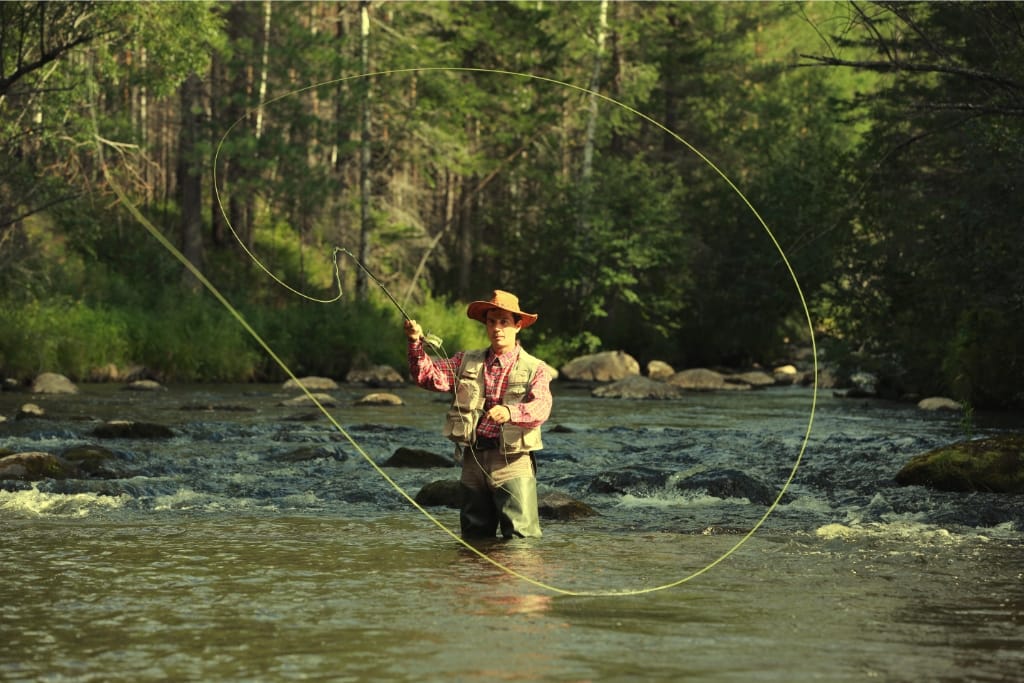Fly fishing is a rewarding outdoor activity that combines skill, patience, and a connection to nature.
For beginners, getting started can feel overwhelming without the right foundation.
By learning a few key techniques and understanding the basics, you can quickly build confidence and start enjoying the serenity and excitement that fly fishing offers.
With the right approach, you'll be casting like a pro in no time—ready to make the most of your time on the water.
1)) Choose The Right Gear
Selecting the right gear is essential to ensure a smooth start in fly fishing. Begin with a beginner-friendly fly rod and reel, ideally sized for the type of fish you'll be targeting and the waters you'll be fishing in.
Pair them with a weight-forward fly line, which makes learning to cast more manageable for newcomers.
Don’t overlook the importance of comfortable waders and boots suited to your fishing environment, as they will keep you dry and provide stability.
The right gear will make your first experiences on the water enjoyable and help you focus on building essential skills.
2)) Learn Basic Casting Techniques
Mastering basic casting techniques is a fundamental step in fly fishing that allows for accurate and effective placement of your fly.
Start by practicing the overhead cast, which involves a smooth and controlled motion to load the rod and propel the line forward.
Focus on timing and wrist movement to ensure a clean delivery. Roll casting is another vital technique, especially when fishing in areas with limited space.
Proper casting requires patience and consistent practice, but gaining confidence in these skills will enhance your ability to reach feeding fish and enjoy more successful outings.
3)) Understand Fish Behavior
Understanding fish behavior is key to increasing your success in fly fishing. Fish are influenced by their environment, including factors such as water temperature, current, and available food sources.
Pay attention to where fish are likely to be, such as near structures like rocks, logs, or shaded areas, as these offer shelter and feeding opportunities.
Observe the surface of the water for signs of activity, like rising fish or insects, to determine the best places to cast.
By studying fish habits and adapting your approach accordingly, you'll improve your chances of a rewarding experience on the water.
4)) Use Appropriate Fly Patterns
Choosing the right fly pattern is essential for enticing fish and mimicking their natural food sources.
Fly patterns are designed to imitate insects, baitfish, or other prey that fish commonly feed on.
Begin by researching the specific aquatic insects or forage that are prevalent in the waters you plan to fish.
Dry flies work well for surface-feeding fish, while nymphs and streamers are effective for subsurface action.
Match the size, color, and type of your fly to the local conditions and the species you are targeting.
Using appropriate fly patterns tailored to the environment will significantly boost your chances of success on the water.
5)) Master Knot Tying
Knot tying is an essential skill in fly fishing that ensures your setup remains secure and functions effectively.
Begin by learning the fundamental knots, such as the improved clinch knot for attaching your fly, the loop-to-loop connection for joining your leader and fly line, and the surgeon’s knot for creating strong leader-to-tippet connections.
Practice tying these knots until you can quickly and confidently assemble your gear, even in challenging conditions.
Properly tied knots prevent lost fish and equipment, giving you greater confidence during your fishing trips and ensuring a more enjoyable experience on the water.
6)) Practice Patience And Observation
Patience and keen observation are vital skills that can greatly enhance your fly fishing success.
Take time to study the water and surroundings before casting, noting signs of fish activity such as surface ripples, splashes, or feeding areas.
Be mindful of the weather, water flow, and insect hatches, as these factors heavily influence fish behavior and feeding patterns.
Avoid rushing; instead, make deliberate and well-considered decisions about where and how to cast.
Developing patience and sharpening your observation skills will help you connect with the environment, make smarter choices, and enjoy a more rewarding fly fishing experience.
7)) Check Regulations And Licenses
Adhering to regulations and acquiring the proper licenses are crucial steps in responsible fly fishing.
Each region has its own set of rules governing fishing seasons, permitted areas, and catch limits, designed to protect fish populations and their habitats.
Familiarize yourself with these guidelines before heading out, as violations can lead to fines and harm to local ecosystems.
Purchasing the required fishing license not only ensures compliance but also supports conservation efforts, as funds are often reinvested into maintaining waterways and habitats.
Being informed and following the rules promotes sustainability and fosters a respectful relationship with nature, allowing future generations to enjoy the sport.
8)) Scout Locations In Advance
Scouting locations in advance is a vital part of planning a successful fly fishing trip.
Researching the area helps you identify promising fishing spots, understand the layout of the water, and learn about local fish species and their habits.
Use maps, guidebooks, and online resources, or speak with local anglers to gather insights into the best access points and times to fish.
Visiting the location beforehand allows you to inspect water conditions, note obstacles, and choose suitable gear and fly patterns for the environment.
Preparing thoroughly ensures a smoother and more productive outing, letting you fully enjoy the experience on the water.
9)) Focus On Water Currents
Understanding water currents is a critical aspect of successful fly fishing, as currents dictate where fish position themselves and how your fly moves in the water.
Fish often conserve energy by staying in slower-moving areas, such as eddies or behind rocks and other obstructions, while waiting for food to drift by in faster currents.
Study the direction and speed of the current, and use techniques like mending your line to achieve a natural fly presentation that mimics the movement of real prey.
Mastering the art of reading water currents will greatly enhance your ability to predict fish behavior and improve your overall fishing efficiency, resulting in more fulfilling outings.
10)) Be Mindful Of Timing And Seasons
Recognizing the importance of timing and seasons can significantly impact your fly fishing success.
Fish behavior is heavily influenced by seasonal changes, water temperature, and light conditions, which affect their feeding patterns and activity levels.
Early mornings and late evenings are often prime times to fish, as many species are more active during these cooler periods.
Certain hatches or fish migrations occur only at specific times of the year, presenting excellent opportunities for anglers.
By understanding these patterns and planning your outings accordingly, you can maximize your chances of encountering active fish and enjoy a more rewarding experience on the water.
11)) Stay Quiet And Minimize Movement
Maintaining a quiet and still presence is a fundamental skill for successful fly fishing, as excessive noise or movement can easily alert fish and cause them to scatter.
Fish are highly sensitive to vibrations and changes in their environment, so subtle adjustments like walking softly, keeping low to the ground, and avoiding abrupt gestures can make a significant difference.
Position yourself carefully, and cast gently to minimize disturbances on the water's surface.
By staying quiet and limiting movement, you create a calm and natural environment that increases your chances of getting closer to fish and achieving a productive and enjoyable fishing experience.
12)) Keep Safety A Priority
Prioritizing safety is essential when fly fishing, as it ensures both an enjoyable and risk-free experience.
Always wear a high-quality pair of waders with a proper fit to prevent water from entering, and use wading boots with good traction to avoid slipping on wet or uneven surfaces.
Carry a personal flotation device if venturing into deeper or faster-moving waters, and keep a first aid kit in your gear for emergencies.
Be mindful of weather conditions, as sudden changes can escalate risks, and never fish alone in remote areas without informing someone of your plans.
By taking these precautions, you can fully concentrate on the joys of fishing while minimizing potential hazards.
Conclusion
Fly fishing is more than just a sport; it is a meaningful connection with nature that combines skill, patience, and respect for the environment.
By taking the time to plan thoroughly, understand the behavior of fish, and follow safety precautions, anglers can enjoy a rewarding and immersive experience on the water.
From scouting the best locations to timing your outing and minimizing your presence, every thoughtful step enhances both the success of the trip and the appreciation of the natural world.
With dedication and mindfulness, fly fishing offers endless opportunities for growth, adventure, and unforgettable memories in the great outdoors.
Download Our Free E-book!







